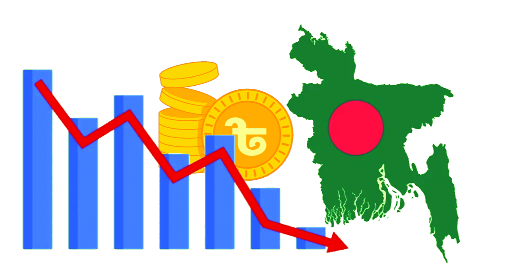Economic crisis maybe long lasting
Mahfuz Emran: In the context of the global economic situation, the negative impact of the ongoing crisis on the domestic macroeconomics is being prolonged. These include rising inflation, pressure on foreign exchange reserves and exchange rate volatility. Real interest rates on deposits have turned negative due to high inflation. which discourages depositors from keeping money in the bank. If these problems are not solved quickly, it is feared that the macroeconomic activities will be disrupted in the long term.
This apprehension has been mentioned in a quarterly report on the Central Bank’s ‘Currency and Currency Exchange Rate’. The report for the October-December 2023 quarter was released on Thursday. While the central bank spoke more negatively about the country’s overall economic situation than at any other time, it also sounded a message of hope. Earlier only optimism was expressed, negative aspects were hidden. As a condition of the government’s loan agreement with the International Monetary Fund (IMF), the central bank is now presenting the country’s overall economic situation more accurately than ever before.
According to the report, contractionary monetary policy is being followed for the second half of the current financial year to deal with the prevailing situation. Inflation rate is decreasing. At present, in the context of macroeconomic conditions, the central bank is playing an effective role by following the policy steps of the government and making necessary adjustments to bring stability to commodity prices besides maintaining the dynamics of domestic growth. In the recent global crisis, steps have been taken to ensure free flow of credit to priority sectors of the economy such as agriculture, export-oriented industries, import-substitute industries and cottage, small and medium industries (CMSMEs). Steps have been taken to reduce the level of non-performing loans, reduce liquidity crunch, curb asset-liability imbalances in the banking sector and achieve the desired economic growth. For this reason, Bangladesh Bank and Government are continuing their concerted efforts.
According to the data obtained from the report, the effect of instability in the main indicators of the economy is prolonged till December of the current financial year. At the same time, most of the targets set to revive the economy have not been achieved. The progress is less than last year. The target was not achieved in any sector of the main indicators of the economy like money flow, domestic credit, private credit, increase in foreign exchange reserves, reduction in inflation rate.
The target of increasing money flow in the market till December of the current financial year was 9.50 percent. On the contrary, it has increased by 8.60 percent. Which is 90 percent less than the target. Inflow of money increased by 8.47 percent during the same period of last financial year. Even though the inflow of money is higher than last financial year, the growth rate is negative if the devaluation of money against the dollar and inflation is excluded.
The reason for this, the central bank said, was a decline in net foreign assets due to lower dollar earnings. Import costs have been reduced to save dollars. Due to this, the flow of money has increased less.
The target of increasing domestic debt was 16.90 percent till December of the current financial year. On the contrary, it has increased by 11.89 percent. In the same period last year, it increased by 14.98 percent. The actual growth of this sector has been less than the target and last year. Gross domestic credit growth is slowing as credit growth in the public and private sectors is low.
The private sector credit growth target was 10.90 percent at the end of December. 10.13 percent has been achieved during that time. In the same period last year, the growth was 12.89 percent. The credit growth of this sector has slowed down compared to the target and last year.
The report commented that the adoption of a contractionary monetary policy to curb the rise in inflation has reduced credit growth. However, credit growth to the private sector is close to the target due to continued supply of needed credit to more productive sectors such as agriculture, CMSMEs and import substitution sectors.
At the end of December, the accumulated net debt position of the government from the banking system increased by 19.77 percent. Which was an increase of 25.19 percent at the end of the same period of the previous year. As a result of the austerity policy adopted by the government in view of the ongoing macroeconomic crisis, the amount of loans provided by the banking system to the public sector has decreased slightly.
While food inflation has eased somewhat in recent times, overall inflation has increased due to higher prices in the non-food sector, particularly apparel and health care products. Mainly due to increase in transport costs, domestic product price disharmony and devaluation of rupee against the dollar have played a key role in increasing the inflation rate.
Meanwhile, Bangladesh Bureau of Statistics (BBS) data shows that the average inflation rate has been increasing till February. However, the point inflation rate rose again in January after a slight decline in December. There is a slight decrease in February. The inflation rate in June 2021 was 5.64 percent. In June 2022, it increased to 7.56 percent. Inflation rate exceeded 9 percent in September of that year. which still continues. In February, this rate was 9.67 percent.
Meanwhile, the average interest rate on bank deposits is below 5 percent. Which is half the rate of inflation. As a result, the interest rate on deposits has become negative due to inflation. This situation discourages the depositors to deposit in the bank.
According to sources, the foreign exchange reserves are still positive as average. Repayment of a large debt reduces the reserve. Although export income and remittances are increasing, reserves are not increasing. Remittances have increased by 7.61 percent till February of the current financial year. It has increased by 4.27 percent in the same period of last financial year. At the same time, growth in export earnings has slowed. The growth was 9.56 percent till February of the last financial year. In the same period of the current financial year, the growth has been 3.71 percent. But for the last 3 months the export earnings are coming in more than $5 billion per month.
Meanwhile, as a result of strict control of expenditure, the expenditure has decreased by 18.17 percent till January of the current financial year. It decreased by 5.67 percent during the same period of last financial year. In recent times the flow of short and medium term foreign loans has been increasing. The flow of dollars increased slightly. But the dollar is not matching the market demand. This increases the external debt repayment pressure. In this, the reserve decreased to $1,945 million. Decreasing reserves put increasing pressure on the dollar. The value of money is decreasing. Which is fueling the inflation rate.
Rare Israeli airstrike in Beirut kills Hezbollah commander and more than a dozen others
International Desk: Israel launched a rare airstrike that killed a senior Hezbollah milita…








